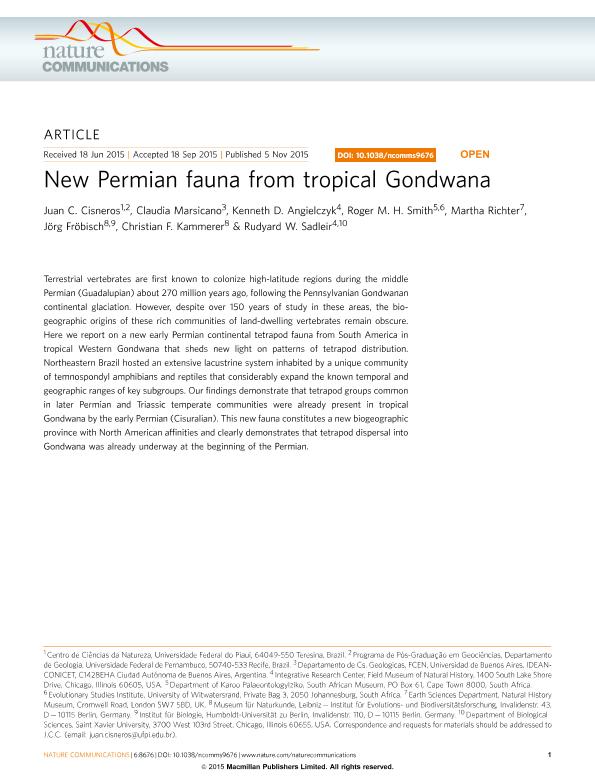Mostrar el registro sencillo del ítem
dc.contributor.author
Cisneros, Juan C.
dc.contributor.author
Marsicano, Claudia Alicia

dc.contributor.author
Angielczyk, Kenneth D.
dc.contributor.author
Smith, Roger M. H.
dc.contributor.author
Richter, Martha
dc.contributor.author
Fröbisch, Jörg
dc.contributor.author
Kammerer, Christian F.
dc.contributor.author
Sadleir, Rudyard W.
dc.date.available
2017-07-28T21:41:42Z
dc.date.issued
2015-11
dc.identifier.citation
Cisneros, Juan C.; Marsicano, Claudia Alicia; Angielczyk, Kenneth D.; Smith, Roger M. H.; Richter, Martha; et al.; New Permian fauna from tropical Gondwana; Nature Publishing Group; Nature Communications; 6; 11-2015; 1-8; 8676
dc.identifier.uri
http://hdl.handle.net/11336/21614
dc.description.abstract
Terrestrial vertebrates are first known to colonize high-latitude regions during the middle Permian (Guadalupian) about 270 million years ago, following the Pennsylvanian Gondwanan continental glaciation. However, despite over 150 years of study in these areas, the biogeographic origins of these rich communities of land-dwelling vertebrates remain obscure. Here we report on a new early Permian continental tetrapod fauna from South America in tropical Western Gondwana that sheds new light on patterns of tetrapod distribution. Northeastern Brazil hosted an extensive lacustrine system inhabited by a unique community of temnospondyl amphibians and reptiles that considerably expand the known temporal and geographic ranges of key subgroups. Our findings demonstrate that tetrapod groups common in later Permian and Triassic temperate communities were already present in tropical Gondwana by the early Permian (Cisuralian). This new fauna constitutes a new biogeographic province with North American affinities and clearly demonstrates that tetrapod dispersal into Gondwana was already underway at the beginning of the Permian.
dc.format
application/pdf
dc.language.iso
eng
dc.publisher
Nature Publishing Group

dc.rights
info:eu-repo/semantics/openAccess
dc.rights.uri
https://creativecommons.org/licenses/by-nc-sa/2.5/ar/
dc.subject
Temnospondyli
dc.subject
Cisuralian
dc.subject
Tropical Gondwana
dc.subject
Paleobiogeography
dc.subject.classification
Paleontología

dc.subject.classification
Ciencias de la Tierra y relacionadas con el Medio Ambiente

dc.subject.classification
CIENCIAS NATURALES Y EXACTAS

dc.title
New Permian fauna from tropical Gondwana
dc.type
info:eu-repo/semantics/article
dc.type
info:ar-repo/semantics/artículo
dc.type
info:eu-repo/semantics/publishedVersion
dc.date.updated
2017-07-13T18:16:08Z
dc.identifier.eissn
2041-1723
dc.journal.number
6
dc.journal.pagination
1-8; 8676
dc.journal.pais
Reino Unido

dc.journal.ciudad
Londres
dc.description.fil
Fil: Cisneros, Juan C.. Universidade Federal do Piau; Brasil. Universidade Federal de Pernambuco; Brasil
dc.description.fil
Fil: Marsicano, Claudia Alicia. Consejo Nacional de Investigaciones Científicas y Técnicas. Oficina de Coordinación Administrativa Ciudad Universitaria. Instituto de Estudios Andinos "Don Pablo Groeber". Universidad de Buenos Aires. Facultad de Ciencias Exactas y Naturales. Instituto de Estudios Andinos "Don Pablo Groeber"; Argentina
dc.description.fil
Fil: Angielczyk, Kenneth D.. The Field Museum; Estados Unidos
dc.description.fil
Fil: Smith, Roger M. H.. South African Museum; Sudáfrica. University of Witwatersrand; Sudáfrica
dc.description.fil
Fil: Richter, Martha. Natural History Museum; Reino Unido
dc.description.fil
Fil: Fröbisch, Jörg. Museum für Naturkunde; Alemania. Humboldt Universität; Alemania
dc.description.fil
Fil: Kammerer, Christian F.. Humboldt Universität; Alemania
dc.description.fil
Fil: Sadleir, Rudyard W.. The Field Museum; Estados Unidos. Saint Xavier University; Estados Unidos
dc.journal.title
Nature Communications

dc.relation.alternativeid
info:eu-repo/semantics/altIdentifier/doi/http://dx.doi.org/10.1038/ncomms9676
dc.relation.alternativeid
info:eu-repo/semantics/altIdentifier/url/https://www.nature.com/articles/ncomms9676
Archivos asociados
